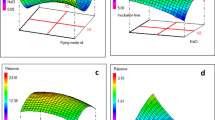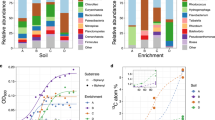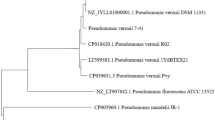Abstract
Naphthenic acids (NAs) occur naturally in oil sands and enter the environment through natural and anthropogenic processes. NAs comprise toxic carboxylic acids that are difficult to degrade. Information on NA biodegradation mechanisms is limited, and there are no studies on alkyl branched aromatic alkanoic acid biodegradation, despite their contribution to NA toxicity and recalcitrance. Increased alkyl side chain branching has been proposed to explain NA recalcitrance. Using soil enrichments, we examined the biodegradation of four aromatic alkanoic acid isomers that differed in alkyl side chain branching: (4′-n-butylphenyl)-4-butanoic acid (n-BPBA, least branched); (4′-iso-butylphenyl)-4-butanoic acid (iso-BPBA); (4′-sec-butylphenyl)-4-butanoic acid (sec-BPBA) and (4′-tert-butylphenyl)-4-butanoic acid (tert-BPBA, most branched). n-BPBA was completely metabolized within 49 days. Mass spectral analysis confirmed that the more branched isomers iso-, sec- and tert-BPBA were transformed to their butylphenylethanoic acid (BPEA) counterparts at 14 days. The BPEA metabolites were generally less toxic than BPBAs as determined by Microtox assay. n-BPEA was further transformed to a diacid, showing that carboxylation of the alkyl side chain occurred. In each case, biodegradation of the carboxyl side chain proceeded through beta-oxidation, which depended on the degree of alkyl side chain branching, and a BPBA degradation pathway is proposed. Comparison of 16S rRNA gene sequences at days 0 and 49 showed an increase and high abundance at day 49 of Pseudomonas (sec-BPBA), Burkholderia (n-, iso-, tert-BPBA) and Sphingomonas (n-, sec-BPBA).
Similar content being viewed by others
Log in or create a free account to read this content
Gain free access to this article, as well as selected content from this journal and more on nature.com
or
Accession codes
References
Acuña Alvarez L, Exton DA, Timmis KN, Suggett DJ, McGenity TJ . (2009). Characterization of marine isoprene-degrading communities. Environ Microbiol 11: 3280–3291.
Alexander M . (1999). Biodegradation and Bioremediation. Academic Press: London.
Beam HW, Perry JJ . (1974). Microbial degradation and assimilation of n-alkyl-substituted cycloparaffins. J Bacteriol 118: 394–399.
Biryukova OV, Fedorak PM, Quideau SA . (2007). Biodegradation of naphthenic acids by rhizosphere microorganisms. Chemosphere 67: 2058–2064.
Blakley ER . (1974). The microbial degradation of cyclohexane carboxylic acid:a pathway involving aromatization to form p-hydroxybenzoic acid. Can J Microbiol 20: 1297–1306.
Blakley ER . (1978). The microbial degradation of cyclohexanecarboxylic acid by a beta-oxidation pathway with simultaneous induction to the utilization of benzoate. Can J Microbiol 24: 847–855.
Blakley E, Papish B . (1982). The metabolism of cyclohexanecarboxylic acid and 3-cyclohexenecarboxylic acid by Pseudomonas putida. Can J Microbiol 28: 1324–1329.
Brient J, Wessner P, Doly M . (1995). Naphthenic Acids. In: Kroschwitz, J (ed). Encyclopedia of Chemical Technology. John Wiley and Sons: New York, pp 1017–1029.
Clarke KR, Ainsworth M . (1993). A method of linking multivariate community structure to environmental variables. Mar Ecol Prog Ser 92: 205–219.
Clemente JS, MacKinnon MD, Fedorak PM . (2004). Aerobic biodegradation of two commercial naphthenic acids preparations. Environ Sci Technol 38: 1009–1016.
Dawson DA, Schultz TW, Hunter RS . (1996). Developmental toxicity of carboxylic acids to Xenopus embryos: a quantitative structure-activity relationship and computer-automated structure evaluation. Teratogen, Carcinogen Mutagen 16: 109–124.
Del Rio L, Hadwin A, Pinto L, MacKinnon M, Moore M . (2006). Degradation of naphthenic acids by sediment micro-organisms. J Appl Microbiol 101: 1049–1061.
DeSantis TZ, Hugenholtz P, Larsen N, Rojas M, Brodie EL, Keller K et al. (2006a). Greengenes a chimera-checked 16S rRNA gene database and workbench compatible with ARB. Appl Environ Microbiol 72: 5069–5072.
DeSantis TZ, Hugenholtz P, Keller K, Brodie EL, Larsen N, Piceno YM et al. (2006b). NAST: a multiple sequence alignment server for comparative analysis of 16S rRNA genes. Nucl Acids Res 34: W394–W399.
Dokholyan VK, Magomedov AK . (1984). Effects of sodium naphthenate on survival and some physiological-biochemical parameers of some fishes. J Ichthyol 23: 125–132.
Edwards U, Rogall T, Bloecker H, Emde M, Boettger E . (1989). Isolation and direct complete nucleotide determination of entire genes. Characterization of a gene coding for 16S ribosomal RNA. Nucleic Acids Res 17: 7843–7851.
Foght JM, Fedorak PM, Westlake DWS, Boerger HJ . (1985). Microbial content and metabolic activities in the Syncrude tailings pond. AOSTRA J Res 1: 139–146.
Frank RA, Fischer K, Kavanagh R, Burnison BK, Arsenault G, Headley JV . (2009). Effect of carboxylic acid content on the acute toxicity of oil sands naphthenic acids. Environ Sci Technol 43: 266–271.
Griffiths RI, Whiteley AS, O’Donnell AG, Bailey MJ . (2000). Rapid method for coextraction of DNA and RNA from natural environments for analysis of ribosomal DNA- and rRNA-based microbial community composition. Appl Environ Microb 66: 5488–5491.
Hadwin A, Del Rio L, Pinto L, Painter M, Routledge R, Moore M . (2006). Microbial communities in wetlands of the Athabasca oil sands: genetic and metabolic characterisation. FEMS Microbiol Ecol 55: 68–78.
Han X, Scott AC, Fedorak PM, Bataineh M, Martin JW . (2008). Influence of molecular structure on the biodegradability of naphthenic acids. Environ Sci Technol 42: 1290–1295.
Headley JV, McMartin DW . (2004). A Review of the occurrence and fate of naphthenic acids in aquatic environments. J Environ Sci Health 39: 1989–2010.
Headley JV, Peru KM, McMartin DW, Winkler M . (2002a). Determination of dissolved naphthenic acids in natural waters by using negative-ion electrospray mass spectrometry. J AOAC Int 85: 182–187.
Headley J, Tanapat S, Putz G, Peru K . (2002b). Biodegradation kinetics of geometric isomers of model naphthenic acids in Athabasca River water. Can Water Resour J 27: 25–42.
Herman D, Fedorak P, Costerton J . (1993). Biodegradation of cycloalkane carboxylic acids in oil sand tailings. Can J Microbiol 39: 576–580.
Hsu CS, Dechert GJ, Robbins WK, Fukuda EK . (2000). Naphthenic acids in crude oils characterized by mass spectrometry. Energy Fuels 14: 217–223.
Jukes TH, Cantor CR . (1969). Mammalian protein metabolism. Academic Press: New York.
March J . (1985). Advanced organic chemistry. Reactions, Mechanisms and Structure, 3rd Edn, Wiley-Interscience: New York, pp. 1346.
McKew BA, Coulon F, Osborn AM, Timmis KN, McGenity TJ . (2007). Determining the identity and roles of oil-metabolizing marine bacteria from the Thames estuary UK. Environ Microbiol 9: 165–176.
Muyzer G, de Waal EC, Uitterlinden AG . (1993). Profiling of complex microbial populations by denaturing gradient gel electrophoresis analysis of polymerase chain reaction-amplified genes coding for 16S rRNA. Appl Environ Microbiol 59: 695–700.
Nawrocki EP, Eddy SR . (2007). Query-dependent banding (QDB) for faster RNA similarity searches. PLoS Comput Biol 3: e56.
Nicol GW, Tscherko D, Embley TM, Prosser JI . (2005). Primary succession of soil Crenarchaeota across a receding glacier foreland. Environ Microbiol 7: 337–347.
Page RD . (1996). TreeView: an application to display phylogenetic trees on personal computers. Comput Appl Biosci 12: 357–358.
Parameswaran P, Jalili R, Tao L, Shokralla S, Gharizadeh B, Ronaghi M et al. (2007). A pyrosequencing-tailored nucleotide barcode design unveils opportunities for large-scale sample multiplexing. Nucleic Acids Res 35: e130.
Paslawski JC, Headley JV, Hill GA, Nemati M . (2009). Biodegradation kinetics of trans-4-methyl-1-cyclohexane carboxylic acid. Biodegradation 20: 125–133.
Quagraine E, Headley J, Peterson H . (2005a). Is biodegradation of bitumen a source of recalcitrant naphthenic acid mixtures in oil sands tailing pond waters? J Environ Sci Heal A 40: 671–684.
Quagraine E, Peterson H, Headley J . (2005b). In situ bioremediation of naphthenic acids contaminated tailing pond waters in the Athabasca oil sands region- demonstrated field studies and plausible options: a review. J Environ Sci Health A 40: 685–722.
Rho E, Evans W . (1975). The aerobic metabolism of cyclohexanecarboxylic acid by Acinetobacter anitratum. Biochem J 148: 11–15.
Rontani JF, Bonin P . (1992). Utilization of n-alkyl-substituted cyclohexanes by a marine Alcaligenes. Chemosphere 24: 1441–1446.
Saitou N, Nei M . (1987). The neighbor-joining method: a new method for reconstructing phylogenetic trees. Mol Biol Evol 4: 406–425.
Scott AC, MacKinnon MD, Fedorak PM . (2005). Naphthenic acids in Athabasca oil sands tailings waters are less biodegradable than commercial naphthenic acids. Environ Sci Technol 39: 8388–8394.
Smith BE . (2006). Naphthenic acids: synthesis characterisation and factors influencing environmental fate [PhD Thesis]. Plymouth (UK). The University of Plymouth, 2006.
Smith BE, Lewis CA, Belt ST, Whitby C, Rowland SJ . (2008). Effects of alkyl chain branching on the biotransformation of naphthenic acids. Environ Sci Technol 42: 9323–9328.
Smith BE, Rowland SJ . (2008). A derivatisation and liquid chromatography/electrospray ionisation multistage mass spectrometry method for the characterisation of naphthenic acids. Rapid Comm in Mass Spect 22: 3909–3927.
Taylor DG, Trudgill PW . (1978). Metabolism of cyclohexane carboxylic acid by Alcaligenes strain W1. J Bacteriol 134: 401–411.
Thomas KV, Langford K, Petyersen K, Smith AJ, Tollefsen KE . (2009). Effect-directed identification of naphthenic acids as important in vitro xeno-estrogens and anti-androgens in North Sea offshore produced water discharges. Environ Sci Technol 43: 8066–8071.
Tokuyama T, Kaneda T . (1973). Corynebacterium cyclohexanicum n. sp.: a cyclohexanecarboxylic acid utilizing bacterium. Can J Microbiol 19: 937–942.
Troussellier M, Bouvy M, Courties C, Dupuy C . (1997). Variation of carbon content among bacterial species under starvation condition. Aquat Microb Ecol 13: 113–119.
Trudgill PW . (1984). Microbial degradation of the alicyclic ring. In: Microbial Degradation of Organic Compounds. Marcel Dekker: New York, pp 131–180.
Videla PP, Farwell AJ, Butler BJ, Dixon DG . (2009). Examining the microbial degradation of naphthenic acids using stable isotope analysis of carbon and nitrogen. Water Air Soil Poll 197: 107–119.
Whitby C . (2010). Microbial naphthenic acid degradation. Adv Appl Microbiol 70: 93–125.
Young RF, Wismer WV, Fedorak PM . (2008). Estimating naphthenic acids concentrations in laboratory-exposed fish and in fish from the wild. Chemosphere 73: 498–505.
Zhao YH, Ji GD, Cronin MTD, Dearden JC . (1998). QSAR study of the toxicity of benzoic acids to Vibrio fischeri, Daphnia magna and carp. Sci Total Environ 216: 205–215.
Zou L, Han B, Yan H, Kasperski KL, Xu Y, Hepler LG . (1997). Enthalpy of adsorption and isotherms for adsorption of naphthenic acid onto clays. J Colloid Interf Sci 190: 472–475.
Acknowledgements
We thank Frederic Coulon for assistance with Microtox and the provision of soil samples. This work was supported by an NERC CASE studentship with Oil Plus Ltd (REF: NER/S/A/2006/14134) and the University of Essex. We thank Garth A Jones for useful comments on the paper.
Author information
Authors and Affiliations
Corresponding author
Additional information
Supplementary Information accompanies the paper on The ISME Journal website
Rights and permissions
About this article
Cite this article
Johnson, R., Smith, B., Sutton, P. et al. Microbial biodegradation of aromatic alkanoic naphthenic acids is affected by the degree of alkyl side chain branching. ISME J 5, 486–496 (2011). https://doi.org/10.1038/ismej.2010.146
Received:
Revised:
Accepted:
Published:
Issue date:
DOI: https://doi.org/10.1038/ismej.2010.146
Keywords
This article is cited by
-
Biodegradation of naphthenic acids: identification of Rhodococcus opacus R7 genes as molecular markers for environmental monitoring and their application in slurry microcosms
Applied Microbiology and Biotechnology (2020)
-
Investigating the Microbial Degradation Potential in Oil Sands Fluid Fine Tailings Using Gamma Irradiation: A Metagenomic Perspective
Microbial Ecology (2017)
-
Treatment of raw and ozonated oil sands process-affected water under decoupled denitrifying anoxic and nitrifying aerobic conditions: a comparative study
Biodegradation (2016)



